Tony Bertauski's Blog, page 8
January 7, 2016
Socket Greeny Has My Voice
Most of my books are available in audiobook, but none in my voice. Until now.
I recently decided to give one of my characters a read. I chose Socket because he was my first story and the character I felt most attached to. So I bought a microphone (Snowball) and set up a disturbing little studio in the back closet.
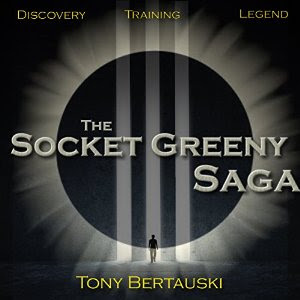 Click to download.
Click to download.Despite blankets draped on the wall, my sound studio wasn't anything close to sound-proof. I read at night when the house was mostly quiet, pausing when a truck would pass nearby or my wife went to the bathroom.
Armed with Audible (free sound mixing software) and a few YouTube videos on correcting mistakes and cleaning up background noise in addition to compressing audio, I went about the business of reading a story.
It's harder than you might think.
I would run out of breath or swallow way too much. This in addition to a flood of mistakes. The mic picks up every tiny sound. I would tell my daughter not to flush the toilet or close a cabinet or think too loudly.
The software turned my voice into something more listenable than I thought possible. And since I knew the characters inside-out, I had an advantage of how to tell the story over another narrator--regardless how silky smooth or professional sounding, they can't know them like I know them.
In the end, I wasn't horrible.
For an extended sample, click below.
22 hours of story.
Get it on Audible.com (HERE) for free with a credit (you get 2 credits for signing up).
http:bertauski.com

THE BERTAUSKI STARTER LIBRARY is FREE!Get 3 full-length novels and 1 novella.CLICK HERE and tell me where to send them.
Published on January 07, 2016 11:00
November 5, 2015
Making Socket Greeny
The prequels are complete.
Three prequels. One for Foreverland, one for Halfskin. And now one for Socket Greeny.
They are all novellas. They are all free. If you've read one or all of the trilogies, you may still enjoy reading how they all came to be. If you haven't read them then you have nothing to lose. The brevity of a novella is a convenient way to test drive a story.
Seeds of Foreverland and The Making of Socket Greeny are original stories. Halfskin (The Vignettes) are the short stories from the Halfskin trilogy; however, there is an original story at the end called 108 Stitches.
Get them today.
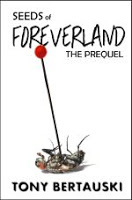
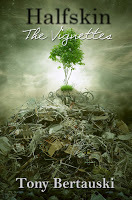
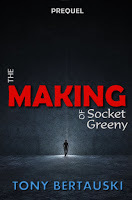
http:bertauski.com

THE BERTAUSKI STARTER LIBRARY is FREE!Get 3 full-length novels and 1 novella.CLICK HERE and tell me where to send them.
Three prequels. One for Foreverland, one for Halfskin. And now one for Socket Greeny.
They are all novellas. They are all free. If you've read one or all of the trilogies, you may still enjoy reading how they all came to be. If you haven't read them then you have nothing to lose. The brevity of a novella is a convenient way to test drive a story.
Seeds of Foreverland and The Making of Socket Greeny are original stories. Halfskin (The Vignettes) are the short stories from the Halfskin trilogy; however, there is an original story at the end called 108 Stitches.
Get them today.



http:bertauski.com

THE BERTAUSKI STARTER LIBRARY is FREE!Get 3 full-length novels and 1 novella.CLICK HERE and tell me where to send them.
Published on November 05, 2015 11:41
September 26, 2015
Boxing Halfskin
The book has been closed on Halfskin, but the door isn't locked.
I began fiction writing several years ago. There was no course planned, no career trajectory charted. It was just leap into one story and then another, each time wondering if I had another story in me. First it was Socket Greeny, then Foreverland followed by Halfskin with Drayton somewhere in the mix. None of the stories seemed to have anything to do with each other.
But that's about to change.
I just boxed Halfskin. All three books in a one convenient package. If you've read the series, drop a review on Amazon for me. Much appreciation will come your way.
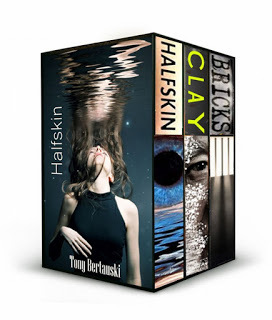
Foreverland and Halfskin story arcs merged in book 3 of both trilogies. The next series will be born out of that merger. Right now, I don't know what it's called or who will be in it, but I know one thing. It will connect Foreverland and Halfskin with Socket Greeny.
All 3 trilogies linked.
Somehow.
I can't wait to see how this happens.
http:bertauski.com

THE BERTAUSKI STARTER LIBRARY is FREE!Get 3 full-length novels and 1 novella.CLICK HERE and tell me where to send them.
I began fiction writing several years ago. There was no course planned, no career trajectory charted. It was just leap into one story and then another, each time wondering if I had another story in me. First it was Socket Greeny, then Foreverland followed by Halfskin with Drayton somewhere in the mix. None of the stories seemed to have anything to do with each other.
But that's about to change.
I just boxed Halfskin. All three books in a one convenient package. If you've read the series, drop a review on Amazon for me. Much appreciation will come your way.

Foreverland and Halfskin story arcs merged in book 3 of both trilogies. The next series will be born out of that merger. Right now, I don't know what it's called or who will be in it, but I know one thing. It will connect Foreverland and Halfskin with Socket Greeny.
All 3 trilogies linked.
Somehow.
I can't wait to see how this happens.
http:bertauski.com

THE BERTAUSKI STARTER LIBRARY is FREE!Get 3 full-length novels and 1 novella.CLICK HERE and tell me where to send them.
Published on September 26, 2015 08:22
August 20, 2015
Back to the Beginning
I love a good prequel.
Years ago, there was a report about readers that enjoy their story more when they know the ending. The tension, some feel, is too much. My daughter is exactly like that. She reads the last chapter and then starts from the beginning. She does the same thing with movies, googling the ending before we watch it.
She's under strict orders not to report that information to me. I love the tension. I want the surprise. I want to guess and pick up the clues.

In full disclosure, I did read the ending once. It was sort of by accident. It was a book called Genesis by Bernard Beckett. I'm such a curmudgeon when it comes to reading that I'll bail if the first chapter doesn't grab me. I was a couple chapters into Genesis and my interest was beginning to wane. I was going to put it down when (and I don't know why) I did something I've never done before.
I read the last page.
And that made all the difference. Beckett had one of the game-changers reserved for the very last page. And that is right up my alley. I read the book with this in mind and had an entirely different experience knowing the twist. It was wonderful.
After finishing the last book in the Halfskin series (Bricks), I sat down to plan out my next project. I'm too late to finish a Claus book for Christmas 2015, so I'm planning to return to that series in 2016. Instead, I came up with the idea of doing prequels for Foreverland, Halfskin, and Socket Greeny.
I am jacked.
These will likely be novellas that cover some bases before each of the series started. I'm currently working on the Foreverland, but the stories are coming fast so I hope to have them out in the next six months or so. Here's what's planned so far.
Stay tuned.
http:bertauski.com

THE BERTAUSKI STARTER LIBRARY is FREE!Get 3 full-length novels and 1 novella.CLICK HERE and tell me where to send them.
Years ago, there was a report about readers that enjoy their story more when they know the ending. The tension, some feel, is too much. My daughter is exactly like that. She reads the last chapter and then starts from the beginning. She does the same thing with movies, googling the ending before we watch it.
She's under strict orders not to report that information to me. I love the tension. I want the surprise. I want to guess and pick up the clues.

In full disclosure, I did read the ending once. It was sort of by accident. It was a book called Genesis by Bernard Beckett. I'm such a curmudgeon when it comes to reading that I'll bail if the first chapter doesn't grab me. I was a couple chapters into Genesis and my interest was beginning to wane. I was going to put it down when (and I don't know why) I did something I've never done before.
I read the last page.
And that made all the difference. Beckett had one of the game-changers reserved for the very last page. And that is right up my alley. I read the book with this in mind and had an entirely different experience knowing the twist. It was wonderful.
After finishing the last book in the Halfskin series (Bricks), I sat down to plan out my next project. I'm too late to finish a Claus book for Christmas 2015, so I'm planning to return to that series in 2016. Instead, I came up with the idea of doing prequels for Foreverland, Halfskin, and Socket Greeny.
I am jacked.
These will likely be novellas that cover some bases before each of the series started. I'm currently working on the Foreverland, but the stories are coming fast so I hope to have them out in the next six months or so. Here's what's planned so far.
Seeds of Foreverland (Foreverland prequel)
The Making of Socket Greeny (Socket Greeny prequel)
One-Skin (Halfskin prequel)
Stay tuned.
http:bertauski.com

THE BERTAUSKI STARTER LIBRARY is FREE!Get 3 full-length novels and 1 novella.CLICK HERE and tell me where to send them.
Published on August 20, 2015 06:41
August 16, 2015
The Finish
Finish strong.
You need a good beginning. Reader's will forgive a sluggish middle, but they'll likely put down a book with a weak beginning. A tepid ending and they'll forget the story, or put it down and think, Meh.
But a strong ending? You've got a fan.
For me, the ending is the most important part of the story. I've forgiven entire stories when the ending is good. For me, good is shocking. Good is I didn't see that coming. Good is the ending that sticks with me for days. As a reader, I want a story that I don't see what's coming next, a story with an ending I can't predict.

Stephen King isn't a strong ender. Probably because he's a pantser, his plots unfold as he writes. He's one of the most prolific and visceral writers alive, always good for a chuckle and a cringe. But more often than not, his endings fizzle instead of pop. (Dr. Sleep was an exception.)
Frequently, I have the ending figured out before I begin writing. The challenge is how to get to it in a plausible, entertaining fashion. How do you put the reader on the edge of her seat, a veritable thrill ride that deposits her in a swoosh of white water excitement? Yeah, that's the challenge.
If I can find an ending that turns the story upside-down (ala Sixth Sense), then I've hit a home run. The conclusion of The Socket Green Saga did that. Foreverland is Dead, too. Halfskin, I was happy with.
More often than not, I want a satisfying conclusion. I don't like cliffhangers, the type of ending that doesn't resolve the plot. You can write a series without that dissatisfaction. Rowlings did it quite well, and we were clamoring for the next book.
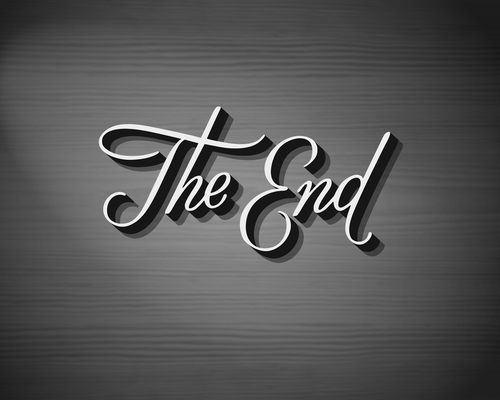
Current work in progress, I have the ending. The character need to get into the basement. That's where the big reveal is going to happen. It will explain the tension going on within the family, will resolve some of the questions existing in the story arc (as well as other questions in subsequent novels since this is a prequel).
So I've got to get him into the basement. It's got to be logical, feasible. Believable.
I know the story arc, know how I want it to start, some of the highlights, but it's got to end up in the basement. With that in mind, I can set up foreshadowing, seed reasons for him getting into the basement. His parents are always down there and it's always locked. Do they just forget to lock it one day? No, that's not feasible. Does he pick the lock? Break through the door? Does he have a reason besides curiosity to get into the basement?
Maybe.
The story can contain tension between Harold, a twelve-year-old boy that is something of an outcast at school, and other students. I'm thinking there can be a scene where the antagonists want payback for something (Harold shoots one in the eye with a pellet gun) and chase him all the way inside the house. Harold panics and runs to the basement to hide. I'm not how he gets down there, but I'll figure that out later.
Yeah. There's something there I like.
It's not totally fleshed out. In fact, when I get to that scene, it's likely to have transformed into something resembling it. Or not at all. But I have something I like, I can feel it. That subtle instinct is connecting with it and I'm ready to start writing toward it.
I like it. And when I'm done, if I still like it, I can only hope readers will like it.
And there's no guarantee that'll happen.
To be continued...
http:bertauski.com
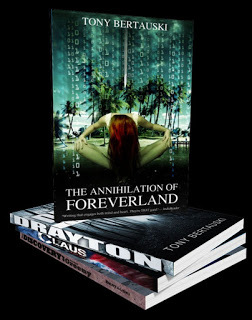
THE BERTAUSKI STARTER LIBRARY is FREE!Get 3 full-length novels and 1 novella.CLICK HERE and tell me where to send them.
You need a good beginning. Reader's will forgive a sluggish middle, but they'll likely put down a book with a weak beginning. A tepid ending and they'll forget the story, or put it down and think, Meh.
But a strong ending? You've got a fan.
For me, the ending is the most important part of the story. I've forgiven entire stories when the ending is good. For me, good is shocking. Good is I didn't see that coming. Good is the ending that sticks with me for days. As a reader, I want a story that I don't see what's coming next, a story with an ending I can't predict.

Stephen King isn't a strong ender. Probably because he's a pantser, his plots unfold as he writes. He's one of the most prolific and visceral writers alive, always good for a chuckle and a cringe. But more often than not, his endings fizzle instead of pop. (Dr. Sleep was an exception.)
Frequently, I have the ending figured out before I begin writing. The challenge is how to get to it in a plausible, entertaining fashion. How do you put the reader on the edge of her seat, a veritable thrill ride that deposits her in a swoosh of white water excitement? Yeah, that's the challenge.
If I can find an ending that turns the story upside-down (ala Sixth Sense), then I've hit a home run. The conclusion of The Socket Green Saga did that. Foreverland is Dead, too. Halfskin, I was happy with.
More often than not, I want a satisfying conclusion. I don't like cliffhangers, the type of ending that doesn't resolve the plot. You can write a series without that dissatisfaction. Rowlings did it quite well, and we were clamoring for the next book.

Current work in progress, I have the ending. The character need to get into the basement. That's where the big reveal is going to happen. It will explain the tension going on within the family, will resolve some of the questions existing in the story arc (as well as other questions in subsequent novels since this is a prequel).
So I've got to get him into the basement. It's got to be logical, feasible. Believable.
I know the story arc, know how I want it to start, some of the highlights, but it's got to end up in the basement. With that in mind, I can set up foreshadowing, seed reasons for him getting into the basement. His parents are always down there and it's always locked. Do they just forget to lock it one day? No, that's not feasible. Does he pick the lock? Break through the door? Does he have a reason besides curiosity to get into the basement?
Maybe.
The story can contain tension between Harold, a twelve-year-old boy that is something of an outcast at school, and other students. I'm thinking there can be a scene where the antagonists want payback for something (Harold shoots one in the eye with a pellet gun) and chase him all the way inside the house. Harold panics and runs to the basement to hide. I'm not how he gets down there, but I'll figure that out later.
Yeah. There's something there I like.
It's not totally fleshed out. In fact, when I get to that scene, it's likely to have transformed into something resembling it. Or not at all. But I have something I like, I can feel it. That subtle instinct is connecting with it and I'm ready to start writing toward it.
I like it. And when I'm done, if I still like it, I can only hope readers will like it.
And there's no guarantee that'll happen.
To be continued...
http:bertauski.com

THE BERTAUSKI STARTER LIBRARY is FREE!Get 3 full-length novels and 1 novella.CLICK HERE and tell me where to send them.
Published on August 16, 2015 09:57
July 27, 2015
The Grind
Writing that opening chapter is exciting.
New characters, a sizzling story arc. There's meat on the bone that makes you salivate for the keyboard. You write the first chapter and it's everything you thought it would be. Maybe more. And then you get to the second chapter and it's a little bland but still good. Third chapter, okay yeah, it's all right. Fourth chapter, you start thinking about another story.
There is no fifth chapter.

Starting a story is easy. The real work is in the middle. For all the romanticizing that goes along with story writing--the characters that talk to us, the story that writes itself, the universes that unfold in our heads--there's a lot of sweat equity left unsaid. Stories that grind to a halt, plots that suddenly unravel, characters that become dull, unlikable assholes. Several authors (including George R.R. Martin and Dorothy Parker) put it this way:
There's no way around the fact that some of this shit takes heavy lifting. Some days the story drips from your fingers like butter. The next day you're Sisyphus. Maybe you'll get lucky and not suffer writer's block, you'll just dictate Mark Twain from beyond. Odds are, you're like the rest of us. That's the deal.

Dedicate yourself to write something, anything. Just write. Everyday, write something. Even if it's not your story, get the words out. You want to drop into the flow, even if its pouring from a sewer. Sometimes the blank page needs a slick layer of vomit to get started. Start writing, even if the mantra in the back of your head tell you,
You'll never arrive at the end without climbing the mountains of trash. Expect to delete. Expect to slash and burn your way through the hubris, to mold that pile of shit into something workable, into a direction, an idea.
This is the gym of the word pimp. These are the days of sweat equity, of building the writer's muscle. It will develop the leather ass that bangs the keys for hours instead of minutes. Most importantly, it cultivates the storyteller compass.
This is the subtle instinct that develops in the gut, that little whisper that says, "Psst. Wrong way." Rather than pushing that boulder up the hill for days, you sense when it's time to stop, to turn around and look for another direction. You'll burn less words, you'll know when you've lost the flow and where to find it. But you won't get there without the mountain.

Outline. Develop. Write. That's my approach. When it falls apart--and it will, often--then go back to the beginning and outline, develop, write. That's the process. That's the climb.
When you're finished, step back and admire. You did that. Yes, you did. And maybe it's still a pile of shit, but that's your pile. And you ain't going anywhere without it. Send it out to the world, see what comes back. Maybe no one loves it but you. Maybe harsh criticism opens your eyes. Then go back, put your feet in the blocks and start again. Enjoy that shit all the way to the end.
Because that's the deal.
To be continued...
http:bertauski.com
THE BERTAUSKI STARTER LIBRARY is FREE!Get 3 full-length novels and 1 novella.CLICK HERE and tell me where to send them.
New characters, a sizzling story arc. There's meat on the bone that makes you salivate for the keyboard. You write the first chapter and it's everything you thought it would be. Maybe more. And then you get to the second chapter and it's a little bland but still good. Third chapter, okay yeah, it's all right. Fourth chapter, you start thinking about another story.
There is no fifth chapter.

Starting a story is easy. The real work is in the middle. For all the romanticizing that goes along with story writing--the characters that talk to us, the story that writes itself, the universes that unfold in our heads--there's a lot of sweat equity left unsaid. Stories that grind to a halt, plots that suddenly unravel, characters that become dull, unlikable assholes. Several authors (including George R.R. Martin and Dorothy Parker) put it this way:
I don't like to write. I like to have been written.
There's no way around the fact that some of this shit takes heavy lifting. Some days the story drips from your fingers like butter. The next day you're Sisyphus. Maybe you'll get lucky and not suffer writer's block, you'll just dictate Mark Twain from beyond. Odds are, you're like the rest of us. That's the deal.

Dedicate yourself to write something, anything. Just write. Everyday, write something. Even if it's not your story, get the words out. You want to drop into the flow, even if its pouring from a sewer. Sometimes the blank page needs a slick layer of vomit to get started. Start writing, even if the mantra in the back of your head tell you,
This is shit. This is shit. This is shit. This is...okay, that's not bad. The rest is shit. But this is all right. I like this.
You'll never arrive at the end without climbing the mountains of trash. Expect to delete. Expect to slash and burn your way through the hubris, to mold that pile of shit into something workable, into a direction, an idea.
This is the gym of the word pimp. These are the days of sweat equity, of building the writer's muscle. It will develop the leather ass that bangs the keys for hours instead of minutes. Most importantly, it cultivates the storyteller compass.
This is the subtle instinct that develops in the gut, that little whisper that says, "Psst. Wrong way." Rather than pushing that boulder up the hill for days, you sense when it's time to stop, to turn around and look for another direction. You'll burn less words, you'll know when you've lost the flow and where to find it. But you won't get there without the mountain.

Outline. Develop. Write. That's my approach. When it falls apart--and it will, often--then go back to the beginning and outline, develop, write. That's the process. That's the climb.
When you're finished, step back and admire. You did that. Yes, you did. And maybe it's still a pile of shit, but that's your pile. And you ain't going anywhere without it. Send it out to the world, see what comes back. Maybe no one loves it but you. Maybe harsh criticism opens your eyes. Then go back, put your feet in the blocks and start again. Enjoy that shit all the way to the end.
Because that's the deal.
To be continued...
http:bertauski.com
THE BERTAUSKI STARTER LIBRARY is FREE!Get 3 full-length novels and 1 novella.CLICK HERE and tell me where to send them.
Published on July 27, 2015 17:07
July 18, 2015
The Twist
Having a story is easy. Telling it is hard.
You're looking at the story from a helicopter. You see all the roads, the cars and characters. You see where they've been, where they're going. You know all the curves of the road, the impending storm, the lay of the land.
Your readers don't.
They see the story one turn at a time. They're on the road surrounded by trees. You want their ride to be enjoyable, sometimes fast, sometimes frightening. Maybe an unexpected turn or new terrain they didn't see coming. You want the ride to be enjoyable.
Satisfying.

But you can never see the road like the reader. You don't have beginner's mind. You already know the story, you've seen it and felt it. The challenge is getting that story in words so the reader experiences the same ups and downs you do writing it. You want enough foreshadowing that they'll be surprised by a turn of events, but not too little that they'll be lost and frustrated.
It's like balancing cats on spinning plates.
You need to satisfy your own writing sensibilities, to have a story that fulfills your vision. But take hints from your readers. Cultivate a group of betareaders--people that will read the rough draft to uncover plot holes or identity confusion. Look for patterns. Only they have the beginner's mind to see it from the road.
You won't please everyone, so don't try. In The Annihilation of Foreverland, reviewers have exclaimed they loved the intrigue and the surprise ending. Other reviewers said it was too easy, they figured out the entire plot in the first chapter.
I have an idea of where my story arc is going, but I don't have it all figured out. There's no way to do that. In fact, I've learned to trust that those little side roads will be revealed as I get down the main road, sometimes making a detour to find an exciting surprise or intriguing side plot, maybe a new character. Sometimes that side road loops back to the beginning where I have to rewrite some scenes or delete them altogether.
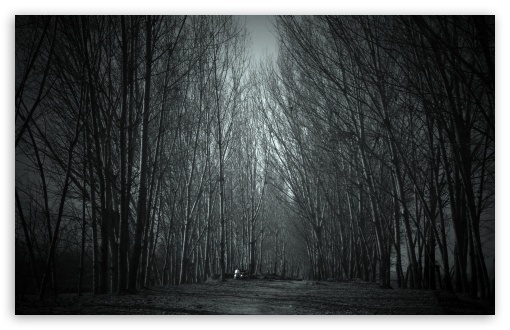
I briefly outline three to five chapters. This might include five or six lines on my legal pad that name characters and scene. What's going to happen? Where are they going? What will they discover?
Next, I outline each chapter in more depth. This might include two or three full pages of legal pad, including brief actions and snippets of dialog. Knowing where I'm going, spying the landscape from the helicopter, helps me settle on the road wearing the reader's eyes. Only I know where I'm going.
Having that big twist in my back pocket helps to foreshadow. A story gets boring when you can predict it. Like they're going meet at the castle and then fight and the good guy wins. I'm not saying the good guy shouldn't win, just not a fairy tale.
Most of the time, I know when the twist is coming. I want the reader breathless when they hit it. I want that experience you get when the wedding band rolls across the floor in the The Sixth Sense. When camera pans down Jaye Davidson in The Crying Game. I want the reader to feel that moment of holy shit.

If you don't have the twist in mind, search for it along the way. You might see it in the trees on your way to the end. Once you find it, you can build foreshadowing on the next pass through. In Foreverland is Dead, I had the twist in mind. It was decent, perhaps not as shocking as I wanted it to be, but I was feeling relatively satisfied. I was wrapping up loose ends in the last chapter, setting up a smooth landing when the real twist popped out of the woods. I was writing the last paragraph, the very last paragraph of the entire book, when it punched me in the face. I was breathless.
That's when the story writes itself.
I went back to the beginning and rewrote scenes, changed names and dropped in hints, this time building up to the real twist. Almost 20,000 words were slashed as a result. But I got the story right. None of your words are sacred. None of them are immortal. Don't be afraid of the hatchet.
Burn the words you don't need. Slay the boring paragraphs. Behead the errant chapters. Do as William Faulkner instructed to leave your readers breathless and satisfied.
Kill your darlings.
To be continued...
http:bertauski.com
THE BERTAUSKI STARTER LIBRARY is FREE!Get 3 full-length novels and 1 novella.CLICK HERE and tell me where to send them.
You're looking at the story from a helicopter. You see all the roads, the cars and characters. You see where they've been, where they're going. You know all the curves of the road, the impending storm, the lay of the land.
Your readers don't.
They see the story one turn at a time. They're on the road surrounded by trees. You want their ride to be enjoyable, sometimes fast, sometimes frightening. Maybe an unexpected turn or new terrain they didn't see coming. You want the ride to be enjoyable.
Satisfying.

But you can never see the road like the reader. You don't have beginner's mind. You already know the story, you've seen it and felt it. The challenge is getting that story in words so the reader experiences the same ups and downs you do writing it. You want enough foreshadowing that they'll be surprised by a turn of events, but not too little that they'll be lost and frustrated.
It's like balancing cats on spinning plates.
You need to satisfy your own writing sensibilities, to have a story that fulfills your vision. But take hints from your readers. Cultivate a group of betareaders--people that will read the rough draft to uncover plot holes or identity confusion. Look for patterns. Only they have the beginner's mind to see it from the road.
You won't please everyone, so don't try. In The Annihilation of Foreverland, reviewers have exclaimed they loved the intrigue and the surprise ending. Other reviewers said it was too easy, they figured out the entire plot in the first chapter.
I have an idea of where my story arc is going, but I don't have it all figured out. There's no way to do that. In fact, I've learned to trust that those little side roads will be revealed as I get down the main road, sometimes making a detour to find an exciting surprise or intriguing side plot, maybe a new character. Sometimes that side road loops back to the beginning where I have to rewrite some scenes or delete them altogether.

I briefly outline three to five chapters. This might include five or six lines on my legal pad that name characters and scene. What's going to happen? Where are they going? What will they discover?
Next, I outline each chapter in more depth. This might include two or three full pages of legal pad, including brief actions and snippets of dialog. Knowing where I'm going, spying the landscape from the helicopter, helps me settle on the road wearing the reader's eyes. Only I know where I'm going.
Having that big twist in my back pocket helps to foreshadow. A story gets boring when you can predict it. Like they're going meet at the castle and then fight and the good guy wins. I'm not saying the good guy shouldn't win, just not a fairy tale.
Most of the time, I know when the twist is coming. I want the reader breathless when they hit it. I want that experience you get when the wedding band rolls across the floor in the The Sixth Sense. When camera pans down Jaye Davidson in The Crying Game. I want the reader to feel that moment of holy shit.

If you don't have the twist in mind, search for it along the way. You might see it in the trees on your way to the end. Once you find it, you can build foreshadowing on the next pass through. In Foreverland is Dead, I had the twist in mind. It was decent, perhaps not as shocking as I wanted it to be, but I was feeling relatively satisfied. I was wrapping up loose ends in the last chapter, setting up a smooth landing when the real twist popped out of the woods. I was writing the last paragraph, the very last paragraph of the entire book, when it punched me in the face. I was breathless.
That's when the story writes itself.
I went back to the beginning and rewrote scenes, changed names and dropped in hints, this time building up to the real twist. Almost 20,000 words were slashed as a result. But I got the story right. None of your words are sacred. None of them are immortal. Don't be afraid of the hatchet.
Burn the words you don't need. Slay the boring paragraphs. Behead the errant chapters. Do as William Faulkner instructed to leave your readers breathless and satisfied.
Kill your darlings.
To be continued...
http:bertauski.com
THE BERTAUSKI STARTER LIBRARY is FREE!Get 3 full-length novels and 1 novella.CLICK HERE and tell me where to send them.
Published on July 18, 2015 10:45
July 15, 2015
The Cast
The people in your head want to be heard.
I don't use index cards in character development. Although that would help to remember the color of eyes or some facial tick, truth is I'm too lazy. I've tried cards, started them and stacked them and did nothing with them. Nowadays, I note the bare essentials on a Word doc and occasionally reference it.
For the most part, I develop characters on legal pad. Big surprise. Before typing the first word, I'll spend two or three weeks doodling characters, flesh out their motivations, their reason to exist. Their story.
Names. Physical attributes. I'll start with those sorts of things. Frequently, I'll change someone's name after the entire rough draft is finished. I work more on why they're in my head than what they look like. In essence, what's their dilemma? What's their conflict? And how are they going to resolve it?
The resolve part, I hope, evolves into the twist--a resolution the reader doesn't see coming. I may or may not come up with that during character development. I primarily focus on two characters: the antagonist you can't quite hate as much as you should and the flawed protagonist.

I put the antagonist first because a really good bad guy is more interesting than the hero. This can be part of the twist, transforming a character from someone you hate into someone you're not sure you hate, or want to hate more than you do. You might even like him or her and don't want to admit it. It's conflicting, but in a good way. Of course, the opposite can be done--from liking a good guy to hating him--but I don't enjoy that direction as much.
I learned a lot from the Joker. Heath Ledger captured the perfect antagonist. He was merciless and deplorable. I shouldn't be rooting for this character, but in the end I just didn't hate him. That's the antagonist I'm looking for. In Socket Greeny, Pike became my Joker. In the end, the motivations for his reprehensible behavior were flipped on its head. In the end, he actually ends up more heroic than antagonistic.
In Halfskin, Marcus Anderson is awful, but he didn't even make the legal pad in the beginning. By the end of the third book, he's a central figure. In Flury, Grandmother is the staunch authoritarian rule maker and child breaker. By the end, you understand her heartache.
As protagonists go, they have to be human. Clark Kent is too good. We can't relate. Even his humble superman persona is off-putting. Batman we can get behind because he's flawed. A wounded hero. His morals won't let allow him to kill someone no matter what atrocities they've committed, but he'll beat them within an inch of their life. And Spawn, well, he's the ultimate bad good guy.
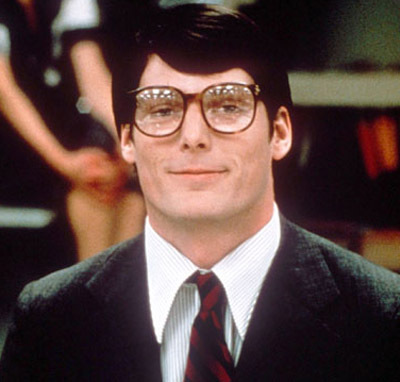
So my character sketches start on a legal pad. Each character has their own page. Name, attributes and what's their problem. On the following pages, I sketch out scenes, how they might interact, where they might be going, what's their ultimate destination.
Dorothy was trying to get back to Kansas, the tin man needed a heart, the lion needed courage... that sort of thing. I'll put stars next to scenes that seem important, or something I really want to get to. It doesn't always work that way, but sometimes I can see the final destination before I start writing.
In Flury, I wanted Oliver to be in a fatal situation and the snowman had to sacrifice himself to save him. By the time I wrote the scene, Oliver was in a diabetic coma and Flury wasn't allowed to leave the property without melting. Cue sadness. I ended up writing that scene three times before I got it right.
In Bricks, I knew the players would be imprisoned on a settlement and would clash with Marcus Anderson. They would escape in pursuit of the truth behind biomites. But after that I didn't know. In fact, I flew through the first two acts and was still stumped when I arrived at the third act some 60,000 words later. So back to the legal pad.
Here's the secret to my legal pad. I almost never look back at it. It's really just a crutch. It's what I use to slow down the story. It's all about letting the characters tell their story, letting the story unfold. I'm just writing it down. Now I want to make it interesting.
I want that twist.
To be continued...
http:bertauski.com
THE BERTAUSKI STARTER LIBRARY is FREE!Get 3 full-length novels and 1 novella.CLICK HERE and tell me where to send them.
I don't use index cards in character development. Although that would help to remember the color of eyes or some facial tick, truth is I'm too lazy. I've tried cards, started them and stacked them and did nothing with them. Nowadays, I note the bare essentials on a Word doc and occasionally reference it.
For the most part, I develop characters on legal pad. Big surprise. Before typing the first word, I'll spend two or three weeks doodling characters, flesh out their motivations, their reason to exist. Their story.
Names. Physical attributes. I'll start with those sorts of things. Frequently, I'll change someone's name after the entire rough draft is finished. I work more on why they're in my head than what they look like. In essence, what's their dilemma? What's their conflict? And how are they going to resolve it?
The resolve part, I hope, evolves into the twist--a resolution the reader doesn't see coming. I may or may not come up with that during character development. I primarily focus on two characters: the antagonist you can't quite hate as much as you should and the flawed protagonist.

I put the antagonist first because a really good bad guy is more interesting than the hero. This can be part of the twist, transforming a character from someone you hate into someone you're not sure you hate, or want to hate more than you do. You might even like him or her and don't want to admit it. It's conflicting, but in a good way. Of course, the opposite can be done--from liking a good guy to hating him--but I don't enjoy that direction as much.
I learned a lot from the Joker. Heath Ledger captured the perfect antagonist. He was merciless and deplorable. I shouldn't be rooting for this character, but in the end I just didn't hate him. That's the antagonist I'm looking for. In Socket Greeny, Pike became my Joker. In the end, the motivations for his reprehensible behavior were flipped on its head. In the end, he actually ends up more heroic than antagonistic.
In Halfskin, Marcus Anderson is awful, but he didn't even make the legal pad in the beginning. By the end of the third book, he's a central figure. In Flury, Grandmother is the staunch authoritarian rule maker and child breaker. By the end, you understand her heartache.
As protagonists go, they have to be human. Clark Kent is too good. We can't relate. Even his humble superman persona is off-putting. Batman we can get behind because he's flawed. A wounded hero. His morals won't let allow him to kill someone no matter what atrocities they've committed, but he'll beat them within an inch of their life. And Spawn, well, he's the ultimate bad good guy.

So my character sketches start on a legal pad. Each character has their own page. Name, attributes and what's their problem. On the following pages, I sketch out scenes, how they might interact, where they might be going, what's their ultimate destination.
Dorothy was trying to get back to Kansas, the tin man needed a heart, the lion needed courage... that sort of thing. I'll put stars next to scenes that seem important, or something I really want to get to. It doesn't always work that way, but sometimes I can see the final destination before I start writing.
In Flury, I wanted Oliver to be in a fatal situation and the snowman had to sacrifice himself to save him. By the time I wrote the scene, Oliver was in a diabetic coma and Flury wasn't allowed to leave the property without melting. Cue sadness. I ended up writing that scene three times before I got it right.
In Bricks, I knew the players would be imprisoned on a settlement and would clash with Marcus Anderson. They would escape in pursuit of the truth behind biomites. But after that I didn't know. In fact, I flew through the first two acts and was still stumped when I arrived at the third act some 60,000 words later. So back to the legal pad.
Here's the secret to my legal pad. I almost never look back at it. It's really just a crutch. It's what I use to slow down the story. It's all about letting the characters tell their story, letting the story unfold. I'm just writing it down. Now I want to make it interesting.
I want that twist.
To be continued...
http:bertauski.com
THE BERTAUSKI STARTER LIBRARY is FREE!Get 3 full-length novels and 1 novella.CLICK HERE and tell me where to send them.
Published on July 15, 2015 13:23
July 14, 2015
The Puzzle
So writing.
Everyone has a process. Finding what works for you is all that matters.
Some folks write by the seat of their pants. They sit in front of a blank screen and just start writing, letting the story unfold with no preconceived notions, no idea where the characters are going. They're called pantsers. For the life of me, I don't know how they do it.
The blank page can be a brick wall and is, in my opinion, the most challenging part of the creative process. I experience a great deal of frustration when I don't know where the story is going. I do not enjoy pantsing. At all.
So I don't do it.

I'm an outliner. I spend an extraordinary amount of time on a legal pad. My process has evolved over the years, and it's been slightly different for each novel. Socket Greeny took three years to finish. Nowadays it takes me 3 to 4 months to get a 90,000 word rough draft.
A novel is technically anything over 40,000 words. The Socket Greeny novels finished under 70,000 words each. Nowadays, I shoot for 90,000 to 100,000 words in the rough draft because I know I'll trim out 10,000 to 20,000 words in the editing process.
Don't worry about word count. Let your story be however long it's going to be. The Drayton stories were all about 10,000 words. I just couldn't seem to turn that character into a novel.
What interests you? I like stories that address reality/consciousness/identity themes. Any story that questions our humanity, what makes us who we are, our place in the universe, the purpose of life. In some ways, I like to write as a thought experiment, to question our preconceptions. Our five senses are not the gold standard for reality. What else is possible?
I also like plot twists, those turns in the road you don't see coming.
Once, I attempted to write a romance novel. I was trying something new. I was 40,000 words into a rough draft and all I could think about was my next sci-fi project. I dropped the romance novel on the spot and never looked back. Again, another 40,000 words that will never see the light of day, but 40,000 words that helped identify my passion.

So my process starts with a legal pad and a cup of coffee. I start with a vague idea of the entire story arc that I know will change. I expect it to, but I need to have a destination to start with. Detours, however, are welcome. In The Annihilation of Foreverland, I wanted teenage boys to wake on a tropical island with no memories where they would slowly discover they were being sent to an alternate reality for all the wrong reasons. That was the big stage. Now for the first act, waking on the island.
I start with a cast of characters, do some brief character sketches, outline physical characteristics and names. Then I outline the first three chapters. In a month or two, I'll start the fourth book in the Claus series. I don't even have a title yet, but I have a character. Aunt Rhonnie will be this over the top, vapid model-chic absent mother with 21st century, first world problems. The arc will be something like A Christmas Carol. That's all I've got so far. But soon I'll sit down with a legal pad and let the process begin.
Outlining means I sit there staring into space while scenes unfold in my head. I write down scant details, just enough to catch the flow, sometimes a quote or specific action. Occasionally the shorthand version of a dialog. This allows me to settle into the scene, to let it develop. To an extent, I'm an observer. And by using a legal pad and pen, I can jot down the notes as they happen because they're unfolding in real time, so to speak, in my head. I can't do that sitting at the computer.
Most of my writing actually gets done on the drive to work, laying in bed, or taking a shower. These are times I can engage the chapter I'm working on, let the characters start again like actors rehearsing. Sometimes I'll make quick notes on my phone or a scratch piece of paper so I don't forget. This is what it means to always be writing, to have the story in the queue when there's downtime. By the time I get to the computer, I have a good idea of where I'm going.

This is what I enjoy so much about writing. It's the challenge of solving the story, this gigantic puzzle that springs from the imagination to engage the reader, to thrill and move the emotions. And it is a challenge. Be prepared to delete often. In Foreverland is Dead, I torched the first 10,000 words because it wasn't going in the right direction. In Halfskin, I started over after 8,000 words because Marcus Anderson came out of nowhere and ended up being a major player in the overall story arc.
So yeah, there's a lot of starting and stopping and going backwards. But that's the process. Enjoy that. Be the biggest fan of your own story. Some readers will join you, others won't care. But your story will always have you. Your characters will have their time in the sun.
Because they're ones telling the story.
To be continued...
http:bertauski.com
THE BERTAUSKI STARTER LIBRARY is FREE!Get 3 full-length novels and 1 novella.CLICK HERE and tell me where to send them.
Everyone has a process. Finding what works for you is all that matters.
Some folks write by the seat of their pants. They sit in front of a blank screen and just start writing, letting the story unfold with no preconceived notions, no idea where the characters are going. They're called pantsers. For the life of me, I don't know how they do it.
The blank page can be a brick wall and is, in my opinion, the most challenging part of the creative process. I experience a great deal of frustration when I don't know where the story is going. I do not enjoy pantsing. At all.
So I don't do it.

I'm an outliner. I spend an extraordinary amount of time on a legal pad. My process has evolved over the years, and it's been slightly different for each novel. Socket Greeny took three years to finish. Nowadays it takes me 3 to 4 months to get a 90,000 word rough draft.
A novel is technically anything over 40,000 words. The Socket Greeny novels finished under 70,000 words each. Nowadays, I shoot for 90,000 to 100,000 words in the rough draft because I know I'll trim out 10,000 to 20,000 words in the editing process.
Don't worry about word count. Let your story be however long it's going to be. The Drayton stories were all about 10,000 words. I just couldn't seem to turn that character into a novel.
What interests you? I like stories that address reality/consciousness/identity themes. Any story that questions our humanity, what makes us who we are, our place in the universe, the purpose of life. In some ways, I like to write as a thought experiment, to question our preconceptions. Our five senses are not the gold standard for reality. What else is possible?
I also like plot twists, those turns in the road you don't see coming.
Once, I attempted to write a romance novel. I was trying something new. I was 40,000 words into a rough draft and all I could think about was my next sci-fi project. I dropped the romance novel on the spot and never looked back. Again, another 40,000 words that will never see the light of day, but 40,000 words that helped identify my passion.

So my process starts with a legal pad and a cup of coffee. I start with a vague idea of the entire story arc that I know will change. I expect it to, but I need to have a destination to start with. Detours, however, are welcome. In The Annihilation of Foreverland, I wanted teenage boys to wake on a tropical island with no memories where they would slowly discover they were being sent to an alternate reality for all the wrong reasons. That was the big stage. Now for the first act, waking on the island.
I start with a cast of characters, do some brief character sketches, outline physical characteristics and names. Then I outline the first three chapters. In a month or two, I'll start the fourth book in the Claus series. I don't even have a title yet, but I have a character. Aunt Rhonnie will be this over the top, vapid model-chic absent mother with 21st century, first world problems. The arc will be something like A Christmas Carol. That's all I've got so far. But soon I'll sit down with a legal pad and let the process begin.
Outlining means I sit there staring into space while scenes unfold in my head. I write down scant details, just enough to catch the flow, sometimes a quote or specific action. Occasionally the shorthand version of a dialog. This allows me to settle into the scene, to let it develop. To an extent, I'm an observer. And by using a legal pad and pen, I can jot down the notes as they happen because they're unfolding in real time, so to speak, in my head. I can't do that sitting at the computer.
Most of my writing actually gets done on the drive to work, laying in bed, or taking a shower. These are times I can engage the chapter I'm working on, let the characters start again like actors rehearsing. Sometimes I'll make quick notes on my phone or a scratch piece of paper so I don't forget. This is what it means to always be writing, to have the story in the queue when there's downtime. By the time I get to the computer, I have a good idea of where I'm going.

This is what I enjoy so much about writing. It's the challenge of solving the story, this gigantic puzzle that springs from the imagination to engage the reader, to thrill and move the emotions. And it is a challenge. Be prepared to delete often. In Foreverland is Dead, I torched the first 10,000 words because it wasn't going in the right direction. In Halfskin, I started over after 8,000 words because Marcus Anderson came out of nowhere and ended up being a major player in the overall story arc.
So yeah, there's a lot of starting and stopping and going backwards. But that's the process. Enjoy that. Be the biggest fan of your own story. Some readers will join you, others won't care. But your story will always have you. Your characters will have their time in the sun.
Because they're ones telling the story.
To be continued...
http:bertauski.com
THE BERTAUSKI STARTER LIBRARY is FREE!Get 3 full-length novels and 1 novella.CLICK HERE and tell me where to send them.
Published on July 14, 2015 06:25
July 12, 2015
The Climb
Socket Greeny.
I can't remember why we named him that. I say we because he started in a joint effort with my son. At the time, he was about 13 years old and haaaaaated to read. Words were like fireants that crawled around his brain when he looked at them. So I started a project where we co-authored a story.
We started with Socket Greeny, a teenage outlier that discovered he was part of an evolved race of humans. We outlined his powers, his clothes and what he was going to do. Even did sketches. We outlined a chapter a week. We quit after a month. Turned out there was one thing my son hated more than reading, and that was writing.
But Socket got inside my head.

Picking up where I'd left off with fiction, I began outlining a story on a legal pad. It's all a bit fuzzy at this point, but I believe I had a vague sense of the entire three book story arc. By vague, I wanted the first book to be about discovering his true nature, the second one about training to be this special person, and third would have some epic betrayal and self-discovery. "You are the key," was a line I heard early on.
I have about a dozen novels now and they all progress a little differently. Sometimes I know the ending and just have to figure out how to get there. Socket Greeny was exactly that.
Once again, naivete can be a beautiful thing.
I entertained Harry Potter fame as I was writing. I knew this was absurd, but a part of my brain believed the world needed to hear the Socket Greeny story. In fact, the world needed to hear it so badly that publishers would start a bidding war when I was finished.
Delusions can be great motivators.
I spent late nights and weekends punching together The Discovery of Socket Greeny. Six months or so later, the rough draft was finished and I gave it to family and friends. And they loved it. Not only was I going to be famous, but rich. Maybe I should just go straight to a publisher, bypass an agent. It was that good.
The reality was this: I still had a lot to learn about fiction writing. I continued reading lots of books on the craft of fiction writing (Self-Editing for Fiction Writers, one my favorites). That was essential in learning the fundamentals of structure and storytelling, the granddaddy axiom of "show, don't tell". Once you have a grasp on storytelling, it'll ruin some of your previously favorite movies (and books).
I eventually spent the money on an editor for an evaluation. The Editorial Department offered several options, all a bit pricey. However, I learned two things. One, I still wasn't ready. And two, editorial input is invaluable. I went through several rounds and eventually came out with a manuscript that was tight and moving.
In the end, Socket Greeny took years to finish. Three or four... I can't remember. During that time, I wrote the entire trilogy six times from scratch. That's 210,000 words from the very beginning, starting completely over. Six times.
Six.
Times.
Still fueled by delusion Socket Greeny would land on a publishers lap and receive gushing enthusiasm, I forged ahead. In retrospect, that wasn't the primary source of inspiration. I loved this character. He was inside my head. The world needed to hear his story. Absurd? Absolutely. And I knew it was, but it was still there, still driving me toward a satisfying conclusion. So yeah, three, four, five, however many years I spent on it didn't matter. It was the process.
The journey. (Yes, cliche, once again. Whatever.)
Were there publishers waiting for me at the top of that climb? Agents with arms out? Nope. Nobody wanted Socket Greeny. Traditional publishing is a tough nut to crack. Even if Socket Greeny was good enough, it was science fiction and, in some ways, young adult. A very narrow genre. After hundreds of query letters to agents and publishers, I accepted Socket Greeny's fate. There would be no book signing tours, no advance royalty checks. It was over.
I was satisfied with the story. It was out. It was a long journey and I was grateful to go along for the ride. I had decided that I would have all three books printed and bound. I would put them on my shelf, a reminder that the journey was complete.
And then Kindle started.
To be continued...
http:bertauski.com
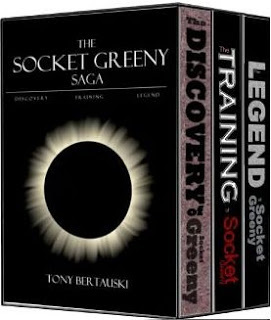
THE BERTAUSKI STARTER LIBRARY is FREE!Get 3 full-length novels and 1 novella.CLICK HERE and tell me where to send them.
I can't remember why we named him that. I say we because he started in a joint effort with my son. At the time, he was about 13 years old and haaaaaated to read. Words were like fireants that crawled around his brain when he looked at them. So I started a project where we co-authored a story.
We started with Socket Greeny, a teenage outlier that discovered he was part of an evolved race of humans. We outlined his powers, his clothes and what he was going to do. Even did sketches. We outlined a chapter a week. We quit after a month. Turned out there was one thing my son hated more than reading, and that was writing.
But Socket got inside my head.

Picking up where I'd left off with fiction, I began outlining a story on a legal pad. It's all a bit fuzzy at this point, but I believe I had a vague sense of the entire three book story arc. By vague, I wanted the first book to be about discovering his true nature, the second one about training to be this special person, and third would have some epic betrayal and self-discovery. "You are the key," was a line I heard early on.
I have about a dozen novels now and they all progress a little differently. Sometimes I know the ending and just have to figure out how to get there. Socket Greeny was exactly that.
Once again, naivete can be a beautiful thing.
I entertained Harry Potter fame as I was writing. I knew this was absurd, but a part of my brain believed the world needed to hear the Socket Greeny story. In fact, the world needed to hear it so badly that publishers would start a bidding war when I was finished.
Delusions can be great motivators.
I spent late nights and weekends punching together The Discovery of Socket Greeny. Six months or so later, the rough draft was finished and I gave it to family and friends. And they loved it. Not only was I going to be famous, but rich. Maybe I should just go straight to a publisher, bypass an agent. It was that good.
The reality was this: I still had a lot to learn about fiction writing. I continued reading lots of books on the craft of fiction writing (Self-Editing for Fiction Writers, one my favorites). That was essential in learning the fundamentals of structure and storytelling, the granddaddy axiom of "show, don't tell". Once you have a grasp on storytelling, it'll ruin some of your previously favorite movies (and books).
I eventually spent the money on an editor for an evaluation. The Editorial Department offered several options, all a bit pricey. However, I learned two things. One, I still wasn't ready. And two, editorial input is invaluable. I went through several rounds and eventually came out with a manuscript that was tight and moving.
In the end, Socket Greeny took years to finish. Three or four... I can't remember. During that time, I wrote the entire trilogy six times from scratch. That's 210,000 words from the very beginning, starting completely over. Six times.
Six.
Times.
Still fueled by delusion Socket Greeny would land on a publishers lap and receive gushing enthusiasm, I forged ahead. In retrospect, that wasn't the primary source of inspiration. I loved this character. He was inside my head. The world needed to hear his story. Absurd? Absolutely. And I knew it was, but it was still there, still driving me toward a satisfying conclusion. So yeah, three, four, five, however many years I spent on it didn't matter. It was the process.
The journey. (Yes, cliche, once again. Whatever.)
Were there publishers waiting for me at the top of that climb? Agents with arms out? Nope. Nobody wanted Socket Greeny. Traditional publishing is a tough nut to crack. Even if Socket Greeny was good enough, it was science fiction and, in some ways, young adult. A very narrow genre. After hundreds of query letters to agents and publishers, I accepted Socket Greeny's fate. There would be no book signing tours, no advance royalty checks. It was over.
I was satisfied with the story. It was out. It was a long journey and I was grateful to go along for the ride. I had decided that I would have all three books printed and bound. I would put them on my shelf, a reminder that the journey was complete.
And then Kindle started.
To be continued...
http:bertauski.com

THE BERTAUSKI STARTER LIBRARY is FREE!Get 3 full-length novels and 1 novella.CLICK HERE and tell me where to send them.
Published on July 12, 2015 12:09



